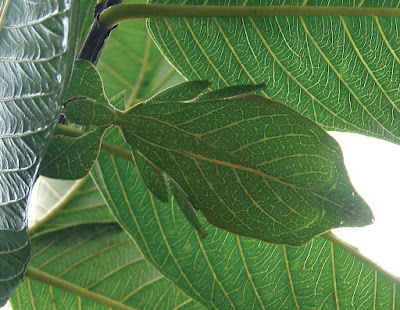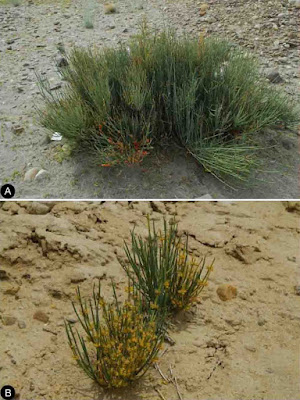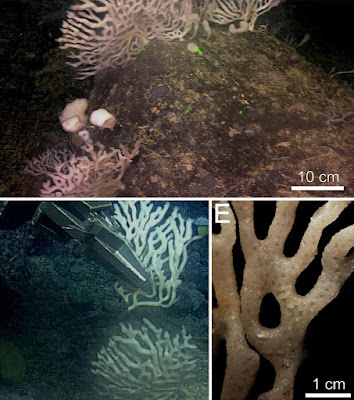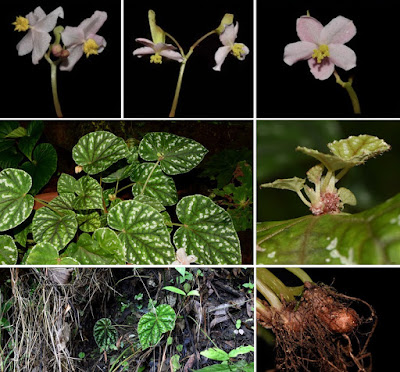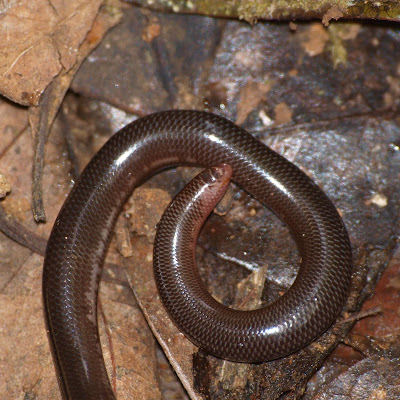[Most Recent Entries] [Calendar View]
Monday, February 22nd, 2021
| Time | Event | ||||
| 1:02p | [Entomology • 2021] Cryptophyllium gen. nov., the Hidden Leaf Insects • Descriptions of A New Leaf Insect Genus and Thirteen Species from the former celebicum Species Group (Phasmatodea, Phylliidae)
Abstract While the leaf insects (Phylliidae) are a well-supported group within Phasmatodea, the genus Phyllium Illiger, 1798 has repeatedly been recovered as paraphyletic. Here, the Phyllium (Phyllium) celebicum species group is reviewed and its distinctiveness from the remaining Phylliini genera and subgenera in a phylogenetic context based on morphological review and a phylogenetic analysis of three genes (nuclear gene 28S and mitochondrial genes COI and 16S) from most known and multiple undescribed species is shown. A new genus, Cryptophyllium gen. nov., is erected to partially accommodate the former members of the celebicum species group. Two species, Phyllium ericoriai Hennemann et al., 2009 and Phyllium bonifacioi Lit & Eusebio, 2014 morphologically and molecularly do not fall within this clade and are therefore left within Phyllium (Phyllium). The transfer of the remaining celebicum group members from Phyllium Illiger, 1798 to this new genus creates the following new combinations; Cryptophyllium athanysus (Westwood, 1859), comb. nov.; Cryptophyllium celebicum (de Haan, 1842), comb. nov.; Cryptophyllium chrisangi (Seow-Choen, 2017), comb. nov.; Cryptophyllium drunganum (Yang, 1995), comb. nov.; Cryptophyllium oyae (Cumming & Le Tirant, 2020), comb. nov.; Cryptophyllium parum (Liu, 1993), comb. nov.; Cryptophyllium rarum (Liu, 1993), comb. nov.; Cryptophyllium tibetense (Liu, 1993), comb. nov.; Cryptophyllium westwoodii (Wood-Mason, 1875), comb. nov.; Cryptophyllium yapicum (Cumming & Teemsma, 2018), comb. nov.; and Cryptophyllium yunnanense (Liu, 1993), comb. nov. The review of specimens belonging to this clade also revealed 13 undescribed species, which are described within as: Cryptophyllium animatum gen. et sp. nov. from Vietnam: Quang Nam Province; Cryptophyllium bankoi gen. et sp. nov. from Vietnam: Quang Ngai, Thua Thien Hue, Da Nang, Gia Lai, Quang Nam, and Dak Nong Provinces; Cryptophyllium bollensi gen. et sp. nov. from Vietnam: Ninh Thuan Province; Cryptophyllium daparo gen. et sp. nov. from China: Yunnan Province; Cryptophyllium echidna gen. et sp. nov. from Indonesia: Wangi-wangi Island; Cryptophyllium faulkneri gen. et sp. nov. from Vietnam: Quang Ngai and Lam Dong Provinces; Cryptophyllium icarus gen. et sp. nov. from Vietnam: Lam Dong and Dak Lak Provinces; Cryptophyllium khmer gen. et sp. nov. from Cambodia: Koh Kong and Siem Reap Provinces; Cryptophyllium limogesi gen. et sp. nov. from Vietnam: Lam Dong, Dak Lak, and Dak Nong Provinces; Cryptophyllium liyananae gen. et sp. nov. from China: Guangxi Province; Cryptophyllium nuichuaense gen. et sp. nov. from Vietnam: Ninh Thuan Province; Cryptophyllium phami gen. et sp. nov. from Vietnam: Dong Nai and Ninh Thuan Provinces; and Cryptophyllium wennae gen. et sp. nov. from China: Yunnan Province. All newly described species are morphologically described, illustrated, and molecularly compared to congenerics. With the molecular results revealing cryptic taxa, it was found necessary for Cryptophyllium westwoodii (Wood-Mason, 1875), comb. nov. to have a neotype specimen designated to allow accurate differentiation from congenerics. To conclude, male and female dichotomous keys to species for the Cryptophyllium gen. nov. are presented. Keywords: Description, Greek Mythology, new species, Phasmida, Phylliini, Phyllium, Southeast Asia, Vietnam Royce T. Cumming, Sarah Bank, Joachim Bresseel, Jérôme Constant, Stéphane Le Tirant, Zhiwei Dong, Gontran Sonet and Sven Bradler. 2021. Cryptophyllium, the Hidden Leaf Insects – Descriptions of A New Leaf Insect Genus and Thirteen Species from the former celebicum Species Group (Phasmatodea, Phylliidae). ZooKeys. 1018: 1-179. DOI: 10.3897/zookeys.1018.61033 | ||||
| 1:11p | [Botany • 2021] Ephedra chengiae (Ephedraceae) • A New Species from Xizang of China
Abstract A new species of Ephedraceae, i.e. Ephedra chengiae sp. nov., is described and illustrated here. This new species is similar to E. rituensis Y.Yang & al. and E. intermedia Schrenk & C.A.Mey. in the erect habit with prominent woody stems, elongated twigs with many nodes, and the long micropylar tube. However, it differs from E. rituensis by the synangia being prominently stipitate (vs. sessile), the female cone having fewer bract pairs (3–4 vs. 4–5), its glossy seeds, and from E. intermedia by the prominently stipitate synangia (vs. sessile or nearly so), the female cone having fewer bract pairs (3–4 vs. 2–5), the glossy seeds (vs. seeds not glossy), and the micropylar tube being more or less straight (vs. twisted). Ephedra chengiae var. spinosa var. nov. differs from var. chengiae in its cushion-like habit and the spinose twigs. Keyword: China, Ephedra rituensis, Ephedra intermedia, Ephedraceae, morphology, new species, taxonomy, Xizang
Ephedra chengiae Y. Yang & D.K. Ferguson, sp. nov. 誠氏麻黃 Diagnosis: This species is similar to Ephedra rituensis Y.Yang et al. and E. intermedia Schrenk & C.A.Mey. in the long micropylar tube, but differs from the latter two species by the stipitate synangia (vs. sessile synangia), female cones having fewer pairs of bracts (3– 4 vs. up to 5), and the glossy seeds (vs. seeds not glossy). Etymology: The specific epithet is derived from Ching-Yung Cheng for her contributions to taxonomic knowledge of Chinese gnetophytes. Prof. Cheng was the author of the Chlamydospermopsida in Flora Reipublicae Popularis Sinicae (Cheng, 1978). Habitat: The species lives in rock crevices or on slopes of sand dunes. Distribution: The species is distributed in western Xizang of China (Fig. 3, black solid square). Ephedra chengiae var. spinosa Y. Yang & D.K. Ferguson, var. nov. 刺枝麻黃 Diagnosis: The new variety differs from E. chengiae var. chengiae in the dwarf and cushion-like habit, straight and spinose twigs with 1–2 internodes (vs. erect shrub, twigs not spinose with more than 3 nodes). Etymology: The specific epithet is derived from the spinose twigs. Distribution: This new variety is only known from Lhozhag County of Xizang in China (Fig. 3, triangle). Yong Yang and David K. Ferguson. 2021. Ephedra chengiae (Ephedraceae), A New Species from Xizang of China. Taiwania. 66(1); 57 - 60. DOI: 10.6165/tai.2021.66.57 | ||||
| 1:43p | [Invertebrate • 2021] Tedania (Tedaniopsis) rappi • Increasing Knowledge of Biodiversity on the Orphan Seamount: A New Species of Tedania (Tedaniopsis) Dendy, 1924 (Demospongiae, Poecilosclerida) A new Tedania species (Porifera) was collect using remotely operated vehicles during the Canadian mission HUD2010-029 and the British RRS Discovery Cruise DY081, on the Orphan Seamount near the Orphan Knoll, northwest Atlantic, between 2999.88 and 3450.4 m depth. Orphan Knoll is an isolated, drowned continental fragment 550 km northeast Newfoundland in the Labrador Sea. This region is biologically rich and complex and in 2007, the regional fisheries management organization operating in the area regulated that no vessel shall engage in bottom-contact fishing activities until reviewed in 2020 with a review slated at the end of this year. Members of the genus Tedania are uncommon in the temperate northern hemisphere with only six species known previously: Tedania (Tedania) anhelans; Tedania (Tedania) pilarriosae; Tedania (Tedania) suctoria; Tedania (Tedania) urgorrii; Tedania (Tedaniopsis) gurjanovae; and Tedania (Tedaniopsis) phacellina. The particular features of the new sponge we describe are the very peculiar external morphology which is tree-like with dichotomous branching—a morphology not previously described in this subgenus; and the combination of spicules found: long styles, the typical tornotes of the subgenus and two sizes of onychaetes. Additional information is provided on other species of Tedaniopsis described from the Atlantic Ocean. Based on the characteristics reported, we propose a new species, Tedania (Tedaniopsis) rappi sp. nov. in honor of Prof. Hans Tore Rapp (1972–2020), University of Bergen, Norway, a renowned sponge taxonomist and coordinator of the Horizon 2020 SponGES project. The holotype of T. (T.) phacellina Topsent, 1912 from the Azores, the only other northern Atlantic species in the subgenus Tedaniopsis, was reviewed for comparison. Keywords: sponges, VMEs, taxonomy, new species, Tedania (Tedaniopsis) rappi Phylum PORIFERA Grant, 1836 Class DEMOSPONGIAE Sollas, 1885 SubClass HETEROSCLEROMORPHA Cárdenaset al., 2012 Order POECILOSCLERIDA Topsent, 1928 Family TEDANIIDAE Ridley and Dendy, 1886 Genus Tedania Gray, 1867 Definition: Tedaniidae with differentiated ectosomal and choanosomal megascleres Van Soest (2002). Subgenus Tedaniopsis Dendy, 1924 Diagnosis: Tedania with relatively long thick, smooth styles, occasionally modified to anisostrongyles or anisoxeas, as structural megascleres. Ectosomal megascleres are mucronate or tylostrongylote tornotes occasionally with one or more vestigial spines (Desqueyroux-Faúndez and Van Soest, 1996). Tedania (Tedaniopsis) rappi Ríos, Cristobo and Kenchington sp. nov. Type material: Holotype: TBD Orphan Seamount (NW Atlantic), 50.1119; −45.3199. Depth 2999.88 m, Coll. CCGS Hudson, 19.07.2010, 1 specimen. Rock substrate. In 70% Ethanol Canadian Museum of Nature number CMNI 2020-0004. Paratype: Atlantic Reference Centre (ARC) Museum (ARC 81604) Orphan Seamount (NW Atlantic), 50.0484; -45.3757, 3,450 m depth, Coll. RRS Discovery, 08.07.2017, 1 specimen. Rock substrate. In 100% Ethanol. Holotype of Tedania (Tedaniopsis) phacellina Topsent, 1912, was revised. Museé Oceanographique Monaco; Collection of S.A.S. Le Prince de Monaco Station 2183, 28th August 1905, 1,998 m in depth. A small fragment (Schizotype) was analyzed by SEM. Derivatio nominis: In honor of Prof. Hans Tore Rapp (1972–2020), University of Bergen, Norway, a renowned sponge taxonomist and dear colleague, who described 50 new species of sponges for science. Prof. Rapp was also coordinator and leader of the EU Horizon 2020 SponGES project which focused much needed attention on deep-sea sponges and their habitats. Pilar Ríos, Javier Cristobo, Emily Baker, Lindsay Beazley, Timothy Culwick and Ellen Kenchington. 2021. Increasing Knowledge of Biodiversity on the Orphan Seamount: A New Species of Tedania (Tedaniopsis) Dendy, 1924. Front. Mar. Sci. 8:612857. DOI: 10.3389/fmars.2021.612857 | ||||
| 1:55p | [Botany • 2021] Begonia murlenensis (Begoniaceae, sect. Platycentrum) • A New Species of Begonia from northeastern India
Abstract A new species of Begonia, Begonia murlenensis (sect. Platycentrum) is described and illustrated from northeastern India. The new species is compared with B. manhaoensis. Diagnostic characters are provided along with a distribution map and notes on its habitat and phenology. Begonia zhongyangiana as a new record in India is also presented here along with a distribution map. Keywords: Mizoram, Murlen, new record, new species, Taxonomy, Eudicots Begonia murlenensis N.Krishna & Pradeep sp. nov. Etymology:—The specific epithet is derived from the name of the type locality, Murlen National Park in Mizoram. Nikhil Krishna, Ayilliath Kuttiyeri Pradeep, Athalappil Amrutha and Thachat Jayakrishnan. 2021. A New Species and A New Record of Begonia (sect. Platycentrum, Begoniaceae) from northeastern India. Phytotaxa. 482(3); 261–267. DOI: 10.11646/phytotaxa.482.3.4 | ||||
| 2:25p | [Herpetology • 2021] Madatyphlops eudelini • Morphological, Osteological, and Genetic Data support A New Species of Madatyphlops (Serpentes: Typhlopidae) endemic to Mayotte Island, Comoros Archipelago
Abstract Blind snakes (Typhlopidae) are an enigmatic group of small burrowing snakes whose anatomy, phylogenetics, and biodiversity remain poorly known. Madatyphlops comorensis (Boulenger, 1889), endemic to the Comoros Archipelago in the Western Indian Ocean, is one of many species whose phylogenetic placement and generic assignment is unclear. We used DNA barcoding, external morphological examination, and osteological data from 3D reconstruction with micro‐CT to study specimens of Madatyphlops from the Comoros Archipelago. Our results support the placement of M. comorensis in Madatyphlops and the recognition of the specimens from Mayotte Island as a closely related but distinct species, which we describe as Madatyphlops eudelini sp. nov. In this context, we present the first detailed osteological descriptions of any species of Madatyphlops, which we hope will serve as groundwork for further osteological studies in this genus and contribute to our limited but growing understanding of the osteology of typhlopid snakes. Keywords: 3D reconstruction, blind snake, Comoros Archipelago, cranial anatomy, Mayotte, micro‐CT, skull Genus Madatyphlops Hedges et al., 2014 Madatyphlops eudelini sp. nov. Etymology: The species epithet is a patronym in honor of Rémy Eudeline, with the last letter removed for better pronunciation. Rémy is a high school teacher of sciences, parataxonomist, and then‐resident of Mayotte, who found the holotype specimen during his first visit to the type locality, after the first author of this publication failed to observe this species in more than 10 surveys of the same locality. Oliver Hawlitschek, Mark D. Scherz, Kathleen C. Webster, Ivan Ineich and Frank Glaw. 2021. Morphological, Osteological, and Genetic Data support A New Species of Madatyphlops (Serpentes: Typhlopidae) endemic to Mayotte Island, Comoros Archipelago. The Anatomical Record. DOI: 10.1002/ar.24589 |
| << Previous Day |
2021/02/22 [Calendar] |
Next Day >> |
